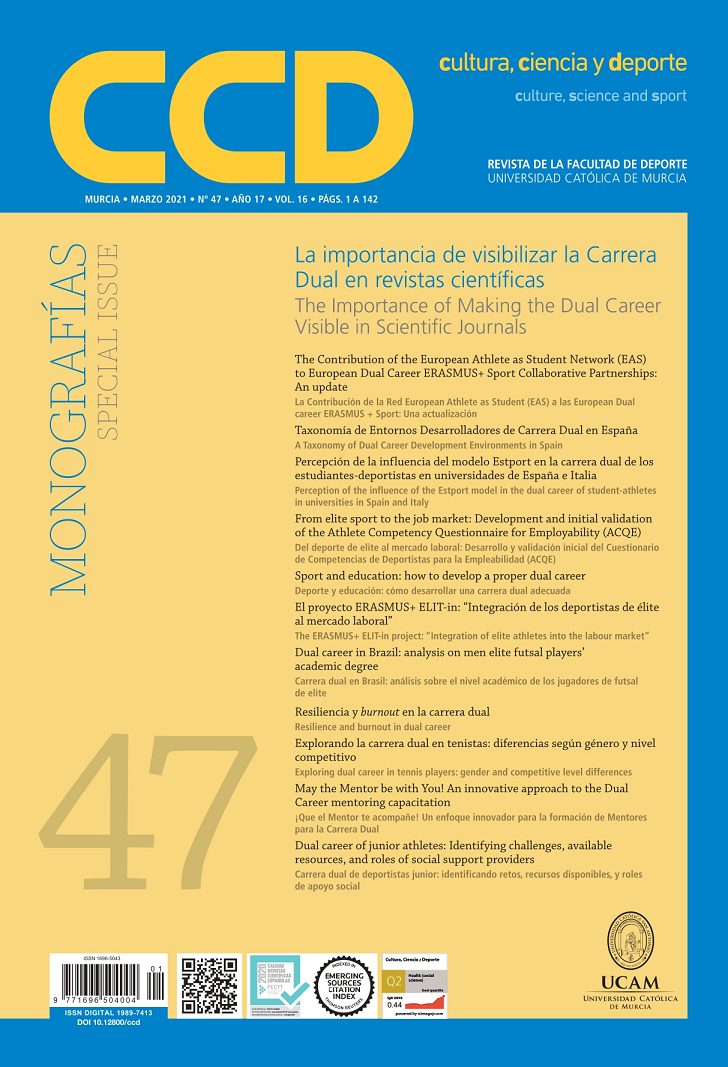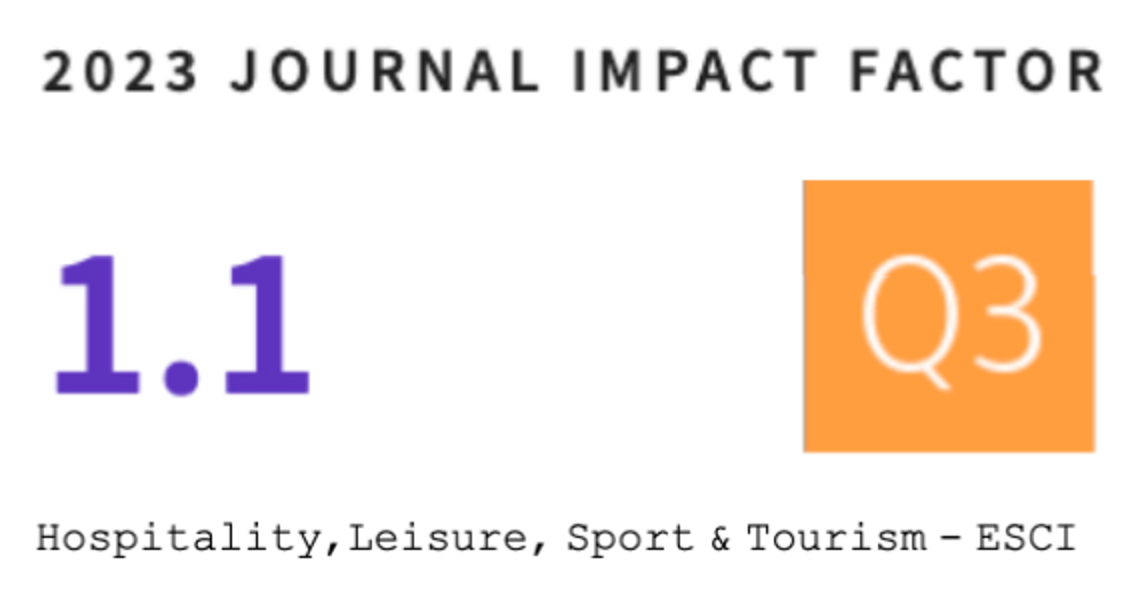The Contribution of the European Athlete as Student Network (EAS) to European Dual Career ERASMUS+ Sport Collaborative Partnerships: An update (La Contribución de la Red European Athlete as Student (EAS) a las European Dual career ERASMUS + Sport: Una actualización)
DOI:
https://doi.org/10.12800/ccd.v16i47.1693Palabras clave:
European dual career, athlete, EAS network, ERASMUS Sport, European Guidelines (Carrera dual, atleta, EAS)Resumen
To inform on the objectives and progression of the AMiD, EMPATIA, DONA, Ed Media, More Than Gold, Starting 11 and SOS ERASMUS+ Sport Collaborative Partnerships in which EAS cooperates with sport bodies and educational institutions to envisage novel solutions for the development of opportunities in education and sport paths of athletes. Dual career dimensions, evidence-and eminence- based methods include literature reviews, and desk, gap, SWOT and PESTEL analyses, focus groups, surveys, semi-structured interviews, workshops, and concept mapping. A limited implementation of the EU guidelines emerged. The findings underline the necessity of maintaining dual career among the European priorities in the field of sport and to envisage a surveillance plan at various dual career environmental levels (e.g., policies, systems, programmes). Through its participation in European projects, EAS contributes to the development of relevant European dual career aspects and to strengthen the link between educational institutions and sports organizations for the benefit of student-athletes.
===
Informar sobre los objetivos y la progresión de las asociaciones colaborativas AMiD, EMPATIA, DONA, Ed Media, More Than Gold, Starting 11 y SOS ERASMUS + Sport en las que EAS coopera con
organismos deportivos e instituciones educativas para generar soluciones novedosas para el desarrollo de oportunidades en caminos educativos y deportivos de los atletas. Los métodos se basaron en evidencia y eminencia que incluyeron revisiones de literatura, SWOT y PESTEL análisis, grupos focales, encuestas, entrevistas semiestructuradas, talleres y mapeo conceptual. Los resultados subrayan la necesidad de mantener la carrera dual entre las prioridades europeas en el campo del deporte y de realizar un plan de vigilancia en los varios niveles de carrera dual (por ejemplo, políticas, sistemas, programas). A través de su participación en proyectos europeos, EAS contribuye al desarrollo de aspectos relevantes de la doble carrera europea y a fortalecer el vínculo entre las instituciones educativas y las organizaciones deportivas en beneficio de los estudiantes-deportistas.
Citas
Amara, M., Aquilina, D., Henry, I., & PMP Consultants (2004). Education of elite young sportspersons in Europe. Brussels: European Commission: DG Education and Culture.
Amsterdam University of Applied Sciences, Birch Consultants, the Talented Athlete Scholarship Scheme, the Vrije Universiteit Brussel & European Athlete as Student Network (2016). Study on the minimum quality requirements for dual career services. Research report. Retrieved from: http://bookshop.europa.eu/is-bin/INTERSHOP.enfinity/WFS/EU-Bookshop-Site/en_GB/-/EUR/ViewPublication-Start?PublicationKey=NC0116370.
Aquilina, D., & Henry, I. (2010). Elite athletes and university education in Europe: A review of policy and practice in higher education in the European Union Member States. International Journal of Sport Policy and Politics, 2, 25-47. https://doi.org/10.1080/19406941003634024.
Baron-Thiene, A., & Alfermann, D. (2015). Personal characteristics as predictors for dual career dropout versus continuation–A prospective study of adolescent athletes from German elite sport schools. Psychology of Sport and Exercise, 21, 42-49. http://dx.doi.org/10.1016/j.psychsport.2015.04.006.
Bastianon, S., & Grieco, G. (2018). The Italian approach to the dual careers of university student-athletes. Kinesiologia Slovenica, 24(3), 5-18.
Borggrefe, C., & Cachay, K. (2012). “Dual Careers”: The structural coupling of elite sport and school exemplified by the German Verbundsysteme. European Journal of Sport and Society, 9, 57–80. http://dx.doi.org/10.1080/16138171.2012.11687889.
Callegaro, M., Manfreda, K.L., & Vehovar, V. (2015). Web Survey Methodology. Thousand Oaks: Sage.
Capranica, L., Foerster, J., Keldorf, O., Leseur, V., Vandewalle, P., Topič, M. D., & Guidotti, F. (2015). The European athlete as student network (“EAS”): Prioritizing dual career of European student-athletes. Kinesiologia Slovenica, 21(2), 5–10.
Capranica, L., & Guidotti, F. (2016). Research for cult committee qualifications/dual careers in sports. European Parliament: Directorate-General for internal policies. Policy Department. Structural and cohesion policies: Cultural and education. Retrieved from: http://www.europarl.europa.eu/RegData/etudes/STUD/2016/573416/IPOL_STU(2016)573416_EN.pdf.
Capranica, L., MacDonncha, C., Blondel, L., Bozzano, E., Burlot, F., Costa, R., Debois, N., Delon, D., Figueiredo, A., Foerster, J., Gjaka, M., Gonçalves, C., Guidotti, F., Lavallee, D., Pesce, C., Pišl, A., Rheinisch, E., Rolo, A., Rozman, S., Ryan, G., Templet, A., Tessitore, A., Varga, K., Warrington, G., & Doupona Topič, M. (2018). Towards the construction of an educational model for dual career parenting: The EMPATIA project. Kinesiologia Slovenica, 24(3): 19-30: 1318-2269.
Condello, G., Capranica, L., Doupona, M., Varga, K., & Burk, V. (2019). Dual-career through the elite university student-athletes’ lenses: The international FISU-EAS survey. PLoS ONE, 14(10), e0223278. https://doi.org/10.1371/journal.pone.0223278.
Condello, G., Ling, F. C. M., Bianco, A., Chastin, S., Cardon, G., Ciarapica, D., ... & Gjaka, M. (2016). Using concept mapping in the development of the EU-PAD framework (EUropean-Physical Activity Determinants across the life course): a DEDIPAC-study. BMC Public Health, 16(1), 1145.
Cousineau, T. M., Houle, B., Bromberg, J., Fernandez, K. C., & Kling, W. C. (2008). A pilot study of an online workplace nutrition program: The value of participant input in program development. Journal of Nutrition, Education and Behavior, 40(3), 160-167.
Donaldson, A., Callaghan, A., Bizzini, M., Jowett, A., Keyzer, P., & Nicholson, M. (2019). A concept mapping approach to identifying the barriers to implementing an evidence-based sports injury prevention programme. Injury Prevention, 25(4), 244-251.
Council of Europe, & European Union (2015). Pro safe sport. Retrieved from: https://pjp-eu.coe.int/en/web/pss/about1.
Elliott, S., Drummond, M. J., & Knight, C. (2018). The experiences of being a talented youth athlete: Lessons for parents. Journal of Applied Sport Psychology, 30(4), 437-455. https://doi.org/10.1080/10413200.2017.1382019.
European Commission (2007). White paper on sport. Retrieved from: http://eur-lex.europa.eu/legalcontent/EN/TXT/PDF/?uri=CELEX:52007DC0391&from=EN.
European Commission (2012). EU guidelines on dual careers of athletes: Recommended policy actions in support of dual careers in high-performance sport. Retrieved from: http://ec.europa.eu/sport/library/documents/dual-career-guidelines-final_en.pdf.
European Commission (2017a). Erasmus+ project results: Enriching lives, opening minds. Retrieved from: http://ec.europa.eu/programmes/erasmus-plus/projects?pk_campaign=Web-ErasmusplusEN&pk_kwd=valor-projects-results#search/keyword=
European Commission (2017b). Report on the state of play concerning the implementation of the EU guidelines on dual careers of athletes.
European Commission (2018). Special Eurobarometer 472: Sport and physical activity. Retrieved from: https://ec.europa.eu/commfrontoffice/publicopinion/index.cfm/Survey/getSurveyDetail/instruments/SPECIAL/search/472/surveyKy/2164.
European Commission (2019). Education and training. Retrieved from: https://ec.europa.eu/education/policies/higher-education/inclusive-and-connected-higher-education_en.
European Commission (2020). Collaborative partnerships. Retrieved from: http://ec.europa.eu/sport/opportunities/sport_funding/transnational_collaborative_projects_en.htm.
European Olympic Committee (2011). Guidelines: Promoting dual career in the EU. Retrieved from: https://sportperformancecentres.org/sites/default/files/A2B_guidelines_final.pdf.
European Parliament (2003). Combining sport and education: Support for athletes in the EU Member States. Retrieved from: https://www.europarl.europa.eu/thinktank/en/document.html?reference=DG-4-CULT_ET(2004)341532.
European Parliament (2015). EU sport policy. An overview. Brussels: European Parliamentary Research Service. (978-92-823-7903-5). Retrieved from: http://www.europarl.europa.eu/RegData/etudes/IDAN/2015/565908/EPRS_IDA(2015)565908_EN.pdf.
European Parliament (2017). European Parliament resolution of 2 February 2017 on an integrated approach to sport policy: Good governance, accessibility and integrity. Retrieved from: http://www.europarl.europa.eu/sides/getDoc.do?type=TA&reference=P8-TA-2017-0012&language=EN&ring=A8-2016-0381.
FISU (2020). Dual career at FISU. Retrieved from: https://www.fisu.net/education/dual-career.
Fuchs, P., Wagner, H., Hannola, H., Niemisalo, N., Pehme, A., Puhke, R., Marinsek, M., Strmecki, A., Svetec, D., Brown, A., Capranica, L., & Guidotti F. (2016). European student-athletes’ perceptions on dual career outcomes and services. Kinesiologia Slovenica, 22(2), 31-48.
Fusco, A., Cortis, C., Castellani, L., Giron, P., Förster, J., Niemisalo, N., Hannola, H., Doupona-Topic, M., Bos, M., Capranica, L., Wagner, H., & Fuchs, P.X. (2019). Student-athletesʼ experience and perception on migration in dual career: The AMiD project. Medicine and Science in Sports and Exercise, 51-S, 733.
Geraniosova, K., & Ronkainen, N. (2015). The experience of dual career through Slovak athletes’ eyes. Physical Culture & Sport. Studies & Research, 66, 53–64. https://doi.org/10.1515/pcssr-2015-0005.
Gjaka, M., Tessitore, A., Blondel, L., Bozzano, E., Burlot, F., Debois, N., Delon, D., Figueiredo, A., Foerster, J., Gonçalves, C., Guidotti, F., Pesce, C., Pišl, A., Rheinisch, E., Rolo, A., Ryan, G., Templet, A., Varga, K., Warrington, G., Capranica, L., MacDonncha, C., & Doupona, M. (Submitted). Understanding the educational needs of parenting dual career athletes: The parents’ view. PlosONE.
Guidotti, F., Cortis, C., & Capranica, L. (2015). Dual career of European student-athletes: A systematic literature review. Kinesiologia Slovenica, 21(3), 5–20.
Guidotti, F., Lupo, C., Cortis, C., Di Baldassarre, A., & Capranica, L. (2014). Italian teachers' perceptions regarding talented atypical students: A preliminary study. Kinesiologia Slovenica, 20(3).
Hakkers, S. (2019). Guidebook of best practices in dual career. How can sport clubs support a talent’s dual career? ICDC & Professorship Elite Sport & Education (Eds.). Retrieved from http://www.icdc.eu/documentacio/20190414_Final_ICDC_guidebook_best_practices.pdf
Harwood, C. G., & Knight, C. J. (2015). Parenting in youth sport: A position paper on parenting expertise. Psychology of Sport and Exercise, 16, 24-35. https://doi.org/10.1016/j.psychsport.2014.03.001.
Hopkins, J., Hopkins, K., & Whelton, B. (2013). Being social: Why the NCAA has forced universities to monitor student-athletes’ social media. University of Pittsburgh Journal of Technology Law and Policy, 13(1), 2-45.
Hoye, R., & Cuskelly, G. (2007). Sport Governance, London: Routledge.
Kamberelis, G., & Dimitriadis, G. (2005). Focus Groups: Strategic Articulations of Pedagogy, Politics, and Inquiry. In N. K. Denzin & Y. S. Lincoln (Eds.), The Sage Handbook of Qualitative Research (pp. 887-907). Thousand Oaks, CA: Sage Publications Ltd.
Kane, M., & Trochim, W. M. (2007). Concept mapping for planning and evaluation (Vol. 50). Thousand Oaks, CA: Sage Publications.
Khan, K. S., Kunz, R., Kleijnen, J., & Antes, G. (2003). Five steps to conducting a systematic review. Journal of the royal society of medicine, 96(3), 118-121.
INEUM Consulting, & TAJ (2008). European Commission study on training of young sportsmen/women in Europe. Brussels: European Commission. Retrieved from: https://www.spordiinfo.ee/est/g22s178.
Izzicupo, P., Di Baldassarre, A., Ghinassi, B., Cánovas Álvarez, F, J., Sánchez-Pato, A., Leiva Arcas, A., García Roca, J. A., Meroño García, L., Vaquero Cristóbal, R., Doupona, M., Figueiredo, A. J., Sarmento, H., Vaz, V., Radu, L. E., Rus, C. M., Rusu, O. M., Abelkalns, I., Bisenieks, U., Peagle, A., Stonis, J., & Capranica L. (submitted). Dual career of athletes during COVID-19 lockdown. PlosOne.
Lapland University of Applied Sciences, Talented Athletes Scholarship Scheme, University of Maribor, University of Rome Foro Italico, University of Salzburg, University of Tartu (2017). Facilitating higher education for athletes – WINNER education model: Final report.
Larsen, M. (2013). Better boards stronger sport. Presentation at the 2013 EU Sport Forum. Retrieved from: https://ec.europa.eu/assets/eac/sport/library/documents/eusf2013-1-2-wkshp2-3-sra.pdf.
Li, M., & Sum, R. K. W. (2017). A meta-synthesis of elite athletes’ experiences in dual career development. Asia Pacific Journal of Sport and Social Science, 6(2), 99-117. https://doi.org/10.1080/21640599.2017.1317481.
Palumbo, F., Cortis C., Fusco A., & Capranica L. (in press). Student-athlete migration: A systematic literature review. Human Movement.
Parker, A., & Tritter, J. (2006). Focus group method and methodology: current practice and recent de-bate. International Journal of Research & Method in Education, 29(1), 23-37.
Portuguese Parliament (2019). Decreto-Lei n.º 55/2019 - Diário da República n.º 1.ª série - N.º 80 - 24 de abril de 2019 (Decree Law 55/2019 - Republica Register n. 1, n.80 - April 24 2019). Retrieved from: https://dre.pt/home/-/dre/calendar/normal/I?day=2019-04-24&date=2019-04-01.
PwC & CONI (2016). Study on sport qualifications acquired through sport organisations and (sport) educational institutes. Retrieved from: https://op.europa.eu/en/publication-detail/-/publication/28026772-9ad0-11e6-868c-01aa75ed71a1.
Ryba, T. V., Schinke, R. J., Stambulova, N. B., & Elbe, A. M. (2018). ISSP position stand: Transnationalism, mobility, and acculturation in and through sport. International Journal of Sport and Exercise Psychology, 16(5), 520-534.
Ryba, T. V., Stambulova, N., Selänne, H., Aunola, K., & Nurmi, J.-E. (2017). “Sport has always been first for me” but “all my free time is spent doing homework”: Dual career styles in late adolescence. Psychology of Sport and Exercise, 33, 131-140. https://doi.org/10.1016/j.psychsport.2017.08.011.
Sanchez-Pato, A., Isidori, E., Calderón, A., & Brunton, J. (2014). An innovative European sports tutorship model of the dual career of student-athletes. UCAM Catholic University of Murcia.
Stambulova, N., & Wylleman, P. (2015). Dual career development and transitions. Psychology of Sport and Exercise, 21, 1-3.
Stambulova, N. B., & Wylleman, P. (2019). Psychology of athletes' dual careers: A state-of-the-art critical review of the European discourse. Psychology of Sport and Exercise, 42, 74-88. https://doi.org/10.1016/j.psychsport.2018.11.013.
Stradi, F. (2020). E-learning e allenamento: la ricetta delle giovani atlete del futuro (E-learning and training: The recipe for the young female athletes of the future). Virtual Coffee of UNISport Italia. Retrieved from https://www.unisport-italia.it/news/2020/06/01/i-caffe-virtuali-di-unisport-italia-5-appuntamento/
Tekavc, J., Wylleman, P., & Erpič, S. C. (2015). Perceptions of dual career development among elite level swimmers and basketball players. Psychology of Sport and Exercise, 21, 27-41. http://dx.doi.org/10.1016/j.psychsport.2015.03.002.
Tessitore, A., Capranica, L., Pesce, C., Dubois, N., Gjaka, M., Warrington, G., MacDonncha, C., & Doupona, M. (Submitted) Parents about parenting dual career athletes: A systematic literature review. Psychology of Sport and Exercise.
Trochim, W. M. (1989). An introduction to concept mapping for planning and evaluation. Evaluation and Program Planning, 12(1), 1-16.
Van Slingerland, K. J., Durand-Bush, N., & Kenttä, G. (2020). Collaboratively designing the Canadian Centre for Mental Health and Sport (CCMHS) using Group Concept Mapping. Journal of Applied Sport Psychology, 1-25.
Visek, A. J., Achrati, S. M., Mannix, H. M., McDonnell, K., Harris, B. S., & DiPietro, L. (2015). The fun integration theory: toward sustaining children and adolescents sport participation. Journal of Physical Activity and Health, 12(3), 424-433.
Zimbalist, A. (2001). Unpaid professionals: Commercialism and conflict in big-time college sports. Princeton University Press.
Wylleman, P., De Brandt, K., & Defruyt, S. (2017). GEES Handbook for dual career support providers (DCSPs). Retrieved from https://www.researchgate.net/profile/Koen_Brandt/publication/340789896_Gold_in_Education_and_Elite_Sport_GEES_Handbook_for_Dual_Career_Support_Providers/links/5e9dc6b64585150839ef1bdc/Gold-in-Education-and-Elite-Sport-GEES-Handbook-for-Dual-Career-Support-Providers.pdf
Descargas
Publicado
Cómo citar
Número
Sección
Licencia
Los autores que publican en esta revista están de acuerdo con los siguientes términos:- Los autores conservan los derechos de autor y garantizan a la revista el derecho de ser la primera publicación del trabajo al igual que licenciado bajo una Creative Commons Attribution License que permite a otros compartir el trabajo con un reconocimiento de la autoría del trabajo y la publicación inicial en esta revista.
















